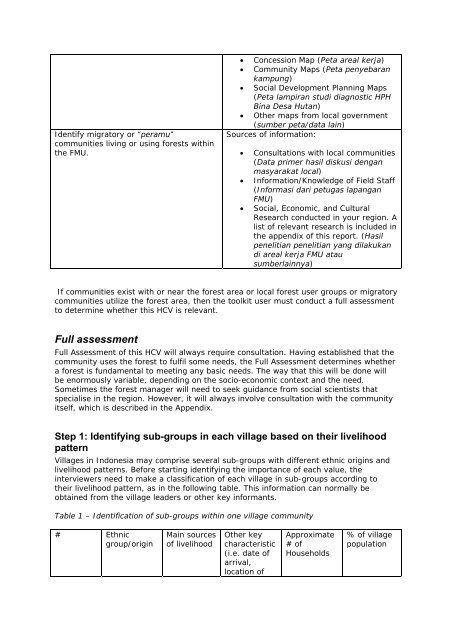English - HCV Resource Network
English - HCV Resource Network
English - HCV Resource Network
You also want an ePaper? Increase the reach of your titles
YUMPU automatically turns print PDFs into web optimized ePapers that Google loves.
Identify migratory or “peramu”<br />
communities living or using forests within<br />
the FMU.<br />
• Concession Map (Peta areal kerja)<br />
• Community Maps (Peta penyebaran<br />
kampung)<br />
• Social Development Planning Maps<br />
(Peta lampiran studi diagnostic HPH<br />
Bina Desa Hutan)<br />
• Other maps from local government<br />
(sumber peta/data lain)<br />
Sources of information:<br />
• Consultations with local communities<br />
(Data primer hasil diskusi dengan<br />
masyarakat local)<br />
• Information/Knowledge of Field Staff<br />
(Informasi dari petugas lapangan<br />
FMU)<br />
• Social, Economic, and Cultural<br />
Research conducted in your region. A<br />
list of relevant research is included in<br />
the appendix of this report. (Hasil<br />
penelitian penelitian yang dilakukan<br />
di areal kerja FMU atau<br />
sumberlainnya)<br />
If communities exist with or near the forest area or local forest user groups or migratory<br />
communities utilize the forest area, then the toolkit user must conduct a full assessment<br />
to determine whether this <strong>HCV</strong> is relevant.<br />
Full assessment<br />
Full Assessment of this <strong>HCV</strong> will always require consultation. Having established that the<br />
community uses the forest to fulfil some needs, the Full Assessment determines whether<br />
a forest is fundamental to meeting any basic needs. The way that this will be done will<br />
be enormously variable, depending on the socio-economic context and the need.<br />
Sometimes the forest manager will need to seek guidance from social scientists that<br />
specialise in the region. However, it will always involve consultation with the community<br />
itself, which is described in the Appendix.<br />
Step 1: Identifying sub-groups in each village based on their livelihood<br />
pattern<br />
Villages in Indonesia may comprise several sub-groups with different ethnic origins and<br />
livelihood patterns. Before starting identifying the importance of each value, the<br />
interviewers need to make a classification of each village in sub-groups according to<br />
their livelihood pattern, as in the following table. This information can normally be<br />
obtained from the village leaders or other key informants.<br />
Table 1 – Identification of sub-groups within one village community<br />
# Ethnic<br />
group/origin<br />
Main sources<br />
of livelihood<br />
Other key<br />
characteristic<br />
(i.e. date of<br />
arrival,<br />
location of<br />
Approximate<br />
# of<br />
Households<br />
% of village<br />
population

















